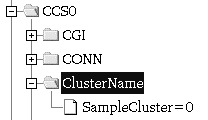Stop the Netscape Application Server whose registry you will edit.
Be aware that editing the server registry while the Netscape Application
Server is running can cause serious problems. Also, some changes take
effect only after the engine is recycled.
Open the registry editor.
The registry editor displays the keys and values that apply to the Netscape
Application Serve. The appearance varies slightly between the UNIX and
Windows NT systems.
Open the registry folder. Notice that this path differs slightly from the previous path that was used to modify or create a cluster.
The following figure displays a registry section on a UNIX system in which
the Default cluster has already been renamed "SampleCluster:"
The same information displays in regedit on a Windows NT system, but in
two side-by-side windows.
KIVA\\Enterprise\\2.0\\CCS0\\ClusterName

Rename the key under ClusterName to the name of the cluster to which the synchronizer should connect.
If this key has not been previously modified, then the name under
ClusterName will be Default. For more information about the Default
cluster, see "Modifying the Default Cluster for Fast Cluster Set Up."
Close the registry editor when you are finished. The synchronizer should now be mapped to the cluster